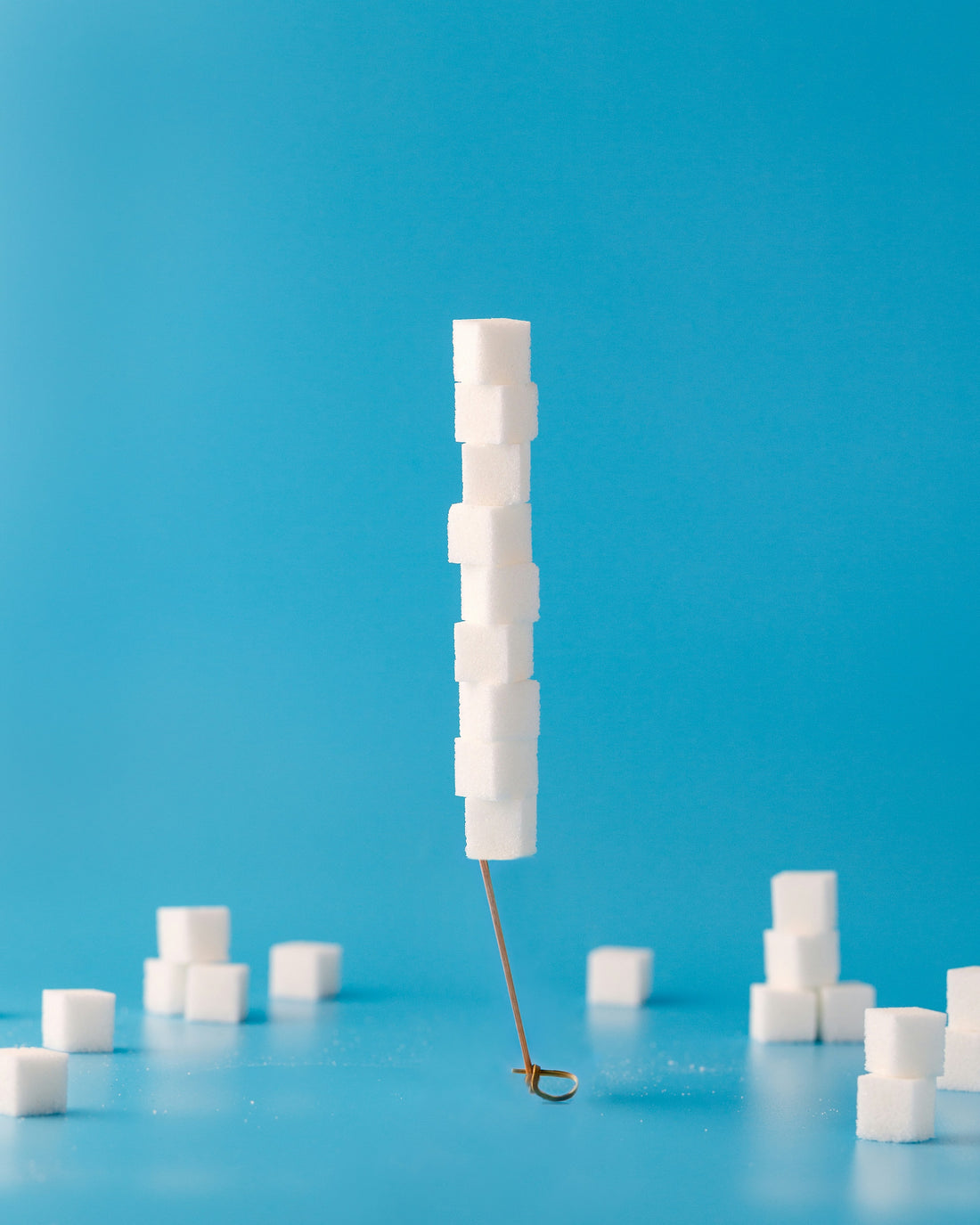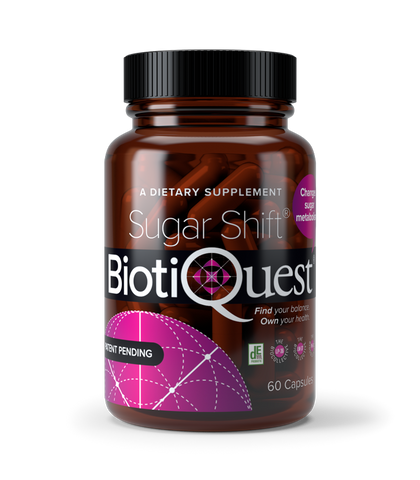

From dipping your spoon into a rich chocolate dessert, pouring syrup onto a stack of fluffy pancakes to rushing through your morning for that first sip of a sugar-laden cuppa (the average vanilla latte at Starbucks contains roughly 35 g of sugar) — represents the everyday Western diet. But, did you know that sugar, the star ingredient in many daily lives, promotes gut inflammation that can turn into disease?
Excessive sugar consumption is associated with a multitude of health concerns like type 2 diabetes, NAFLD (non-alcoholic fatty liver disease), obesity, Irritable bowel disease (IBD), increased risk of cardiovascular disease (high blood cholesterol and stroke), cognitive decline including neurodegenerative diseases such as Parkinson's and Alzheimer's, and even some types of cancers.
Want to learn how sugar consumption might end up wreaking havoc on your health by instigating gut and systemic inflammation? How chronic inflammation stimulates a cascade of events that eventually show up as metabolic and autoimmune diseases such as type 2 diabetes and irritable bowel syndrome?
Let’s dive in and find out ways to redirect your gut health and strive towards a healthier life.
How does sugar consumption take a turn toward inflammation?
While sugars found in fruit and veggies come as a complete package including fiber and nutrients, added sugar in processed foods and sugary drinks is used as high fructose corn syrup (HFCS) made from fructose and glucose containing roughly 55% to 42% fructose.
Word of caution: A lot of fruit today has been engineered to have higher levels of sugar (measured in °Bx) and reduced fiber content.
Excessive consumption of simple sugars can be a trigger for metabolic syndrome which includes risk factors such as insulin resistance, high blood pressure, high blood cholesterol, and obesity which together might increase your risk of type 2 diabetes, heart disease, and stroke.

Sugar and Dysbiosis
The foods you consume feed not only you but also the trillions of microbes living in your gut. In a healthy gut environment, a diverse community of bacteria thrive within a symbiotic community.
When you consume a large variety of whole foods, you sustain a diverse and competitive gut microbiome. But a compromised diet — that is low in fiber, high in sugar and/or unhealthy fats or any combination thereof — besides factors such as antibiotic treatments, genetics, age, stress, environment, lifestyle, etc., can cause an imbalance between different microbial families in the gut, known as dysbiosis.
When sugar absorption channels in the gut get saturated, residual sugars such as fructose and its metabolites can provide a growth medium for gram-negative bacterial families and lead to an increased amount of endotoxins in the gut.
A study conducted to elaborate on the effects of fructose on the gut found that mice that were fed a fructose-rich diet had an increase in Proteobacteria. Proteobacteria are one of the major sources of lipopolysaccharides (LPS) in the gut, an endotoxin associated with inflammation.
A study comparing the differences in the effects of fruit fructose and HFCS on the gut microbiome found that while a fruit-rich diet led to an increase in the Firmicutes phylum containing butyrate-forming bacteria (a bacterial by-product that has anti-inflammatory effects) such as Anaerostipes, Faecalibacterium and decrease in the abundance of Parabacteroides (a pathogenic bacterial species), HFCS containing diets led to a decrease in Firmicutes and an increase in Bacteroidetes.
Differences in dysbiosis
The relationship between the abundance of different bacterial phyla, for instance, Firmicutes to Bacteroidetes ratio might be used as a marker to predict health vs different disease states.
An increase in the F/B ratio, which can either be because of an increase in Firmicutes or a decrease in Bacteroidetes, has been associated with obesity. A decrease in the F/B ratio, which can either be because of a decrease in Firmicutes or an increase in Bacteroidetes, has been associated with Irritable bowel disease (IBD).
A diet high in added sugars leads to a decrease in gut bacterial diversity and an overgrowth of sugar-loving bacteria. Researchers studying the effects of sugar on the gut microbial composition in mice observed a significant decrease in gut diversity after a 7-day treatment with glucose, fructose, and sucrose.
An abundance of the gut wall (mucin) degrading gram-negative bacterial phyla such as Verrucomicrobia, Akkermansiaceae, Bacteroidaceae, and Marinilabilia increased while relative abundances of gram-positive bacteria such as Firmicutes, Clostridiales, Lactobacillaceae, and Ruminococcaceae decreased.
An increase in mucin-degrading bacteria is a common disease marker seen in inflammatory conditions such as IBD.

Dysbiosis and the immune system
An increase in certain types of bacteria, such as Provetella can lead to an increase in lipopolysaccharides (LPS) in the gut and blood circulation. LPS is a part of the outer cell wall of gram-negative bacteria and is an endotoxin that has been associated with chronic inflammation.
What forms a healthy gut barrier and how does it protect you?
The intestinal wall is a physical and functional barrier that separates the contents of the gut from the rest of the body. The gut barrier can selectively allow or limit distinct elements of the gut from passing into the blood circulation while keeping you protected against pathogens and endotoxins. It comprises multiple protective layers that include:
- The inner and outer mucus (gel-like) layer — houses commensal (beneficial) gut bacteria, antibacterial proteins (AMPs), and gut specific antibodies (sIgA)
- A single epithelial cell layer, which includes special cells that produce protective enzymes such as the intestinal alkaline phosphatase (IAP) and antibacterial peptides like defensins and lysozymes.
- The external connective tissue layer (inner lamina propria - which contains immune cells)
Different elements of the gut wall act in function specific ways to maintain a protective wall between the gut and the rest of the body. For instance, Glycocalyx is a thick fuzzy coating that surrounds epithelial cells and facilitates the attachment of beneficial bacteria as well as acts as a defense mechanism against pathogenic bacteria.
Similarly, IAP functions to inactivate bacterial endotoxins such as LPS. The mucus layer provides a physical barrier that keeps pathogenic bacteria from sticking to the epithelial cells and instigating a pro-inflammatory immune response.
Nutrient absorption such as amino acids, electrolytes, short-chain fatty acids, etc can occur either by passing through or in between epithelial cells. Complex protein structures like tight junction proteins, adherens junctions act as mortar between individual epithelial cells allowing smaller molecules to pass through while restricting bigger molecules within the gut.

Increased bacterial endotoxins trigger inflammation
Dysbiotic gut bacteria can alter gut barrier integrity and make it easier to breach, allowing still active LPS to leak through and come in contact with locally present immune cells, triggering a cascade of inflammatory events that can eventually lead to local and systemic inflammation that can cause type 2 diabetes, NAFLD and IBD.
For example - Zonulin, a protein that modulates gut barrier permeability can become compromised based on gut microbial composition. Some evidence suggests an association between an increased presence of gram-negative bacteria such as Proteobacteria with increased zonulin expression.
Continued exposure to LPS can trigger sustained low-grade inflammation which can start liver disease such as NAFLD, etc. In the short term, inflammation is a protective response, but prolonged inflammation can lead to damage across the body that might cause the development of a range of diseases.
Several studies have found links between an increased intake of added sugars (glucose, fructose, sucrose, HFCS) and low-grade chronic inflammation, fat accumulation, obesity, insulin resistance, type 2 diabetes, rheumatoid arthritis, multiple sclerosis, psoriasis, cardiovascular disease, and irritable bowel disease.
Irritable Bowel Disease and Type 2 Diabetes
As we’ve seen earlier, a rise in the abundance of different bacteria can give rise to different disease states. Irritable bowel disease can either present as Crohn's disease or as ulcerative colitis. Both forms affect different parts of the gut but the commonality between the two is dysbiosis-led gut inflammation.
An increase in mucin-degrading bacteria such as Bacteroides fragilis, Akkermansia muciniphila, Clostridium sp., Helicobacter pylori, and Prevotella sp., etc thins the mucus layer of the gut wall, giving opportunistic bacteria access to the gut epithelial cell layer. Locally present immune cells identify and react to these pathogens and trigger an inflammatory reaction.
Type 2 Diabetes
Pancreatic β-cells handle insulin secretion and having an optimum supply of insulin is essential for a multitude of metabolic functions including storing excess sugar, lowering blood sugar, and feeling satiated.
Persistent high blood sugar has been associated with triggering inflammation and oxidative stress that can slowly damage pancreatic β-cells which over time compromises insulin production and increases insulin resistance. Insulin resistance can build silently for years before it shows up as prediabetes. Besides diabetes, insulin resistance is also a prevalent marker in NAFLD and obesity.

Combating sugar-driven inflammation
A balanced gut microbiome is essential to a healthy body because it generates a range of metabolites that your body needs and cannot generate independently. Short-chain fatty acids (SCFAs) - butyrate, propionate, and acetate - are generated when probiotic gut bacteria ferment non-digestible complex carbohydrates.
Although you cannot directly break down these complex carbohydrates, probiotic bacteria thrive on a complex carbohydrate diet. SCFAs, especially butyrate, are the primary source of energy for intestinal epithelial cells and enhance the expression of goblet cells (increase mucus production) and tight junction proteins and thus are essential to maintaining gut barrier integrity.
Besides providing energy, SCFAs also attach to receptors in the gut that start the release of satiating (feeling full) hormones that help curb your appetite. SCFAs are an important anti-inflammatory component in the gut.
While LPS instigates a pro-inflammatory response, SCFAs can attach to receptors present in the cells of the gut lining and modulate the immune system, starting an anti-inflammatory effect by switching off inflammation inducing pathways.
A human study in IBD patients showed a significant lack of butyrate-producing bacteria Faecalibacterium prausnitzii and found butyrate supplementation to have a positive impact on IBD patients.
One of the best ways to curb inflammation is to have a diet and lifestyle that discourages dysbiosis and encourages a balanced gut microbiome.
Diet and probiotics
Prebiotics are foods that feed the good bacteria in your gut. Complex carbohydrates such as resistant starches found in green bananas, cashew nuts, etc, or soluble and insoluble fibers found in green leafy vegetables, fruit and veggies, etc are an excellent starting point when you’re building a health regime focussed on redirecting your gut health.
While adding prebiotic-rich foods such as beans and lentils to your diet, make sure to select produce that has not been dried out by using glyphosate (a herbicide that has been associated with harmful effects on the health)
 Besides a range of prebiotics, you can introduce butyrate-producing beneficial bacteria found in fermented foods and probiotic supplements. Ideal Immunity® contains probiotic strains such as B. bifidum, L. plantarum, L. reuteri, and B. subtilis that produce anti-inflammatory compounds and might help strengthen your gut lining.
Besides a range of prebiotics, you can introduce butyrate-producing beneficial bacteria found in fermented foods and probiotic supplements. Ideal Immunity® contains probiotic strains such as B. bifidum, L. plantarum, L. reuteri, and B. subtilis that produce anti-inflammatory compounds and might help strengthen your gut lining.
Make the shift with our best-selling patented probiotic Sugar Shift®, rich in beneficial probiotic strains like Leuconostoc mesenteroides (LM-37), Pediococcus acidilactici (PA-68), Lactobacillus paracasei (LP-36), Lactobacillus reuteri (PCR7), Bifidobacterium bifidum, Bifidobacterium longum, and Bacillus subtilis (DE-111). A randomized clinical trial studying the effects of Sugar Shift® on metabolic markers showed a significant decrease in LPS markers in the blood at the end of a 12 week period.
Rebalance your gut environment with Sugar Shift® as it supports you in reducing inflammation, utilizing excess glucose and fructose in the gut to produce mannitol (a powerful free radical scavenger), managing sugar cravings, and helping improve bowel regularity.
Frequently Asked Questions:
Can sugar cause inflammation in the gut?
Yes, several studies associate the consumption of sugar with gut inflammation.
Does quitting sugar reduce inflammation?
Quitting sugar and increasing your intake of prebiotics, fermented foods, and probiotics can help you maintain a healthy gut environment and prevent excessive inflammation.
What does eating too much sugar do to your gut?
Eating too much sugar can spike the abundance of bacteria such as Proteobacteria that have been associated with an increase in inflammation.
Does sugar destroy the gut lining?
Increased sugar consumption has been associated with increased inflammation and a weakened gut lining.
Can too much sugar cause gut problems?
Increased sugar consumption has been associated with multiple metabolic conditions such as low-grade systemic inflammation, insulin resistance, diabetes, NAFLD, and obesity.
How do you reset your gut after overeating sugar?
Quitting or significantly reducing the amount of sugar consumption besides a sustained addition of different sources of complex carbohydrates (whole fruits and veggies), fermented foods, and probiotic supplements such as Ideal Immunity® might help you overcome the effects of excessive sugar consumption and readjust your gut microbiome in the long run.
Sugar consumption easily falls under the umbrella of too much of a good thing and it can alter the course of your health with every spoonful. Check out Sugar, Insulin Resistance, and Parkinson's Disease, if you’re curious about how sugar consumption and associated inflammation can drive the development of Parkinson’s disease.
With gratitude,

 Martha Carlin, is a “Citizen Scientist”,
systems thinker, wife of Parkinson’s warrior, John Carlin, and founder of The BioCollective , a microbiome company expanding
the reach of science and BiotiQuest, the first of it’s kind probiotic line. Since John’s diagnosis in 2002,
Martha began learning the science of agriculture, nutrition, environment, infectious disease, Parkinson’s
pathology and much more. In 2014, when the first research was published showing a connection between the gut
bacteria and the two phenotypes of Parkinson’s, Martha quit her former career as a business turnaround expert
and founded The BioCollective to accelerate the discovery of the impact of gut health on all human disease. Martha was a speaker at the White House 2016 Microbiome Initiative launch, challenging the scientific
community to “think in a broader context”. Her systems thinking background and experience has led to collaborations
across the scientific spectrum from neuroscience to engineering to infectious disease. She is a respected out of the
box problem solver in the microbiome field and brings a unique perspective to helping others understand the
connections from the soil to the food to our guts and our brains.
Martha Carlin, is a “Citizen Scientist”,
systems thinker, wife of Parkinson’s warrior, John Carlin, and founder of The BioCollective , a microbiome company expanding
the reach of science and BiotiQuest, the first of it’s kind probiotic line. Since John’s diagnosis in 2002,
Martha began learning the science of agriculture, nutrition, environment, infectious disease, Parkinson’s
pathology and much more. In 2014, when the first research was published showing a connection between the gut
bacteria and the two phenotypes of Parkinson’s, Martha quit her former career as a business turnaround expert
and founded The BioCollective to accelerate the discovery of the impact of gut health on all human disease. Martha was a speaker at the White House 2016 Microbiome Initiative launch, challenging the scientific
community to “think in a broader context”. Her systems thinking background and experience has led to collaborations
across the scientific spectrum from neuroscience to engineering to infectious disease. She is a respected out of the
box problem solver in the microbiome field and brings a unique perspective to helping others understand the
connections from the soil to the food to our guts and our brains.


Waking Up to a Probiotic Breakfast Can Do Wonders for Your Gut Health
Did you know that recent studies show people with poor gut diversity had lower quality of life? The health of your microbiome impacts your mental health, sleep, energy, the risk for chronic illnesses, and much more. A probiotic breakfast can...

Can Probiotic Supplements Make or Break Your Fast?
Intermittent fasting (IF) may have started as a fitness trend for weight loss, but today it's a go-to lifestyle choice for many. Practicing intermittent fasting has been linked with health benefits such as lowering blood sugar and insulin, preventing heart...














 Martha Carlin
Martha Carlin







